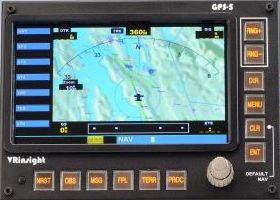This is another area which requires a lot of decision making and planning: now that the cockpit framing is well under way (reminder: the SimSamurai CS-1 Stallion), I have started thinking about the instrument panel.
The plans for the CS-1 Stallion include (obviously) the exact dimensions of the panel available to me. They also show an example layout, but of course, it’s up to me to actually decide on the various components and their layout.
The SimSamurai approach to instrument panels is to use one or two embedded LCD panels for the primary (and perhaps secondary) flight instruments — this has the benefit of keeping the instrument panel flexible, since it is just rendered, rather than having fixed instruments in fixed positions. Since I want to try various different aircraft, this is an important point. Therefore, anything like the VRInsight u-ProPit is not going to be a good choice for me. Of course, having your primary instruments rendered on an LCD in front of you pushes the experience more towards “pretend” and away from “real”, but it’s a trade off I’m happy with.
With the basic instruments covered — all I need is an LCD monitor — the next decision is to choose avionics and panels to add around it. In the back of a closet I already have some Saitek gear: Yoke, throttle, rudder pedals, radio panel and switch panel. So, flight controls are covered, and I don’t want to throw away the two panels I already have. So, the plan is to add more Saitek panels, and make up what’s missing using equipment from Desktop Aviator, VRInsight, and GoFlight, as needed.
Current inventory:
- 19″ LCD for primary flight instruments: I will use this to display the regular 2D panel from FSX, or perhaps upgrade to a slightly larger one
- Two Saitek Radio Panels: Each one has two radios, so I will configure them as follows for my typical VFR flights:
- Radio 1 = COM1 and NAV1
- Radio 2 = DME/ADF and Transponder
- One Saitek Switch Panel: This has the “keys”, main electrical switches, and landing gear. The new 2620 Cessna Switch Panel from Desktop Aviator looks nicer, but that would mean losing the gear control and losing some consistency in the look of the panel, but it’s not totally ruled out at this point…
- One Saitek Multi Panel: This has an autopilot, flaps control, and elevator trim.
- One GoFlight Student Pilot Module. I just acquired one of these on eBay for a really good price: not sure what I will do with it yet (or, in fact, what it can be used for).
Wish List:
These items are high on the wish list:
- The GPS-5 GPS Panel from VRInsight: a little pricey perhaps, but it looks really nice. I’m a bit concerned that it will be hard to flush mount into a panel: it looks like it’s designed to be used standalone. The 2450B GPS Panel from Desktop Aviator is designed for mounting in a panel, but I like the look of the GPS-5 more.
- I was going to use a numeric keypad for the ATC interface in FSX, but then I saw the GF-ATC Air Traffic Communication Module from GoFlight, so that is now added to the wish list too.
- DesktopAviator has both a Fuel Tank Select Switch and a Parking Brake, both of which would make good additions.
Also up for consideration:
- Saitek’s BIP or some other warning light panel (GoFlight has one too)
- Saitek’s Instrument Panel … a couple of these could be used to provide instruments not covered on the main instrument LCD — not sure exactly what, but it would be nice to have the option.
I tried to create a very quick & dirty layout by just placing a few images on a background, and came up with the following. Although the panels are very roughly in the right proportions, I haven’t checked if this actually fits in the panel space available: that will be the next step…
So overall, a lot of work to be done (and a lot of USB connections needed)! It will be interesting to see how my final result compares to the ambitious plans I had at the beginning…











